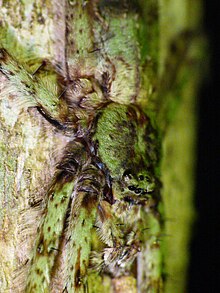| Pandercetes | |
|---|---|

| |
| Pandercetes cf. celatus from the Western Ghats showing typical cryptic patterning | |
|
Scientific classification
| |
| Domain: | Eukaryota |
| Kingdom: | Animalia |
| Phylum: | Arthropoda |
| Subphylum: | Chelicerata |
| Class: | Arachnida |
| Order: | Araneae |
| Infraorder: | Araneomorphae |
| Family: | Sparassidae |
| Genus: |
Pandercetes L. Koch, 1875 [1] |
| Type species | |
|
P. gracilis L. Koch, 1875
| |
| Species | |
|
16, see text | |
Pandercetes is a genus of huntsman spiders that was first described by Ludwig Carl Christian Koch in his 1875 treatise on Australian spiders. [2] They are mainly distributed in tropical Asia and Australia, and are known for their cryptic coloration that matches local moss and lichen. Their legs have lateral hairs, giving them a feathery appearance, further masking their outline against tree trunks. Their head is somewhat elevated and the carapace has the thoracic region low and flat. [3]
The genus is characterized by the internal anatomy of the reproductive structures. Males have irregular coils at the terminal end, while females have screw like copulatory ducts. [4]
Species

As of October 2019 [update] it contains sixteen species and one subspecies, found in tropical forests in Asia, extending east to Australia: [1]
- Pandercetes celatus Pocock, 1899 – India
-
Pandercetes celebensis Merian, 1911 –
Indonesia (
Sulawesi)
- Pandercetes c. vulcanicola Merian, 1911 – Indonesia (Sulawesi)
- Pandercetes decipiens Pocock, 1899 – India, Sri Lanka
- Pandercetes gracilis L. Koch, 1875 ( type) – Indonesia ( Moluccas, Sulawesi), New Guinea, Australia ( Queensland)
- Pandercetes isopus Thorell, 1881 – Indonesia (Moluccas), New Guinea
- Pandercetes longipes Thorell, 1881 – Papua New Guinea (Yule Is.)
- Pandercetes macilentus Thorell, 1895 – Myanmar
- Pandercetes malleator Thorell, 1890 – Malaysia, Indonesia (Aru Is.)
- Pandercetes manoius Roewer, 1938 – New Guinea
- Pandercetes niger Merian, 1911 – Indonesia (Sulawesi)
- Pandercetes nigrogularis ( Simon, 1897) – Indonesia ( Java)
- Pandercetes ochreus Hogg, 1922 – Vietnam
- Pandercetes palliventris Strand, 1911 – New Guinea
- Pandercetes peronianus ( Walckenaer, 1837) – New Zealand
- Pandercetes plumipes ( Doleschall, 1859) – Sri Lanka, Indonesia (Ambon), New Guinea
- Pandercetes plumosus Pocock, 1899 – Papua New Guinea ( New Britain)
See also
References
- ^ a b "Gen. Pandercetes L. Koch, 1875". World Spider Catalog Version 20.0. Natural History Museum Bern. 2019. doi: 10.24436/2. Retrieved 2019-11-13.
- ^ Koch, L. (1875). Die Arachniden Australiens. Nürnberg 1. pp. 577–740.
- ^ Pocock, R.I. (1909). The Fauna of British India, including Ceylon and Burma. Arachnida. London: Taylor and Francis. pp. 259–265.
- ^ Jäger, Peter (2002). "Heteropodinae: Transfers and Synonymies (Arachnida: Araneae : Sparassidae)" (PDF). Acta Arachnologica. 51 (1): 33–61. doi: 10.2476/asjaa.51.33.